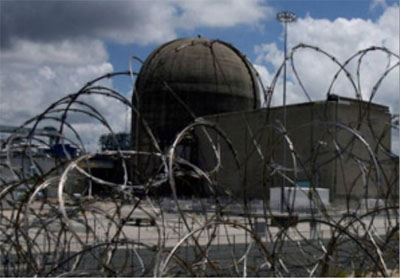Report: South Texas Project faces flood risk
Friday, October 19, 2012
By Jennifer Hiller
San Antonio Express-News

The South Texas Project nuclear power plant in Bay City. SA
The South Texas Project, which provides about a third of San Antonio’s electric power, is on a list of nuclear plants with a high risk of flooding-related failures.
A leaked July 2011 Nuclear Regulatory Commission report labeled “not for public release” deals with flood risk to plants across the country if dams break upstream.
The NRC posted a redacted version of the report to its website in March. But the environmental group Greenpeace obtained an un-redacted version and shared it with The Huffington Post, which first wrote about the full report Friday.
In response, a report Friday from the Union of Concerned Scientists says that the NRC document shows that, “34 reactors — one-third of the U.S. nuclear fleet — may face flooding hazards greater than they are designed to withstand, as a result of the failure of upstream dams. … The NRC has known about some of these problems for 15 years and has not effectively addressed them.”
CPS Energy, San Antonio’s city-owned utility, is an owner of the South Texas Project, along with Austin Energy and NRG Energy Inc.
The report comes in the wake of last year’s disaster at the Fukushima Daiichi nuclear power plant in Japan. In that case, an earthquake and tsunami led to a series of equipment failures and meltdowns, a massive evacuation and environmental damage.
The other U.S. plants deemed to be at flood risk were in Alabama, Arkansas, Louisiana, Minnesota, Nebraska, New Jersey, New York, North Carolina, Pennsylvania, Tennessee, South Carolina, Vermont, Virginia and Washington state.
“Failure of one or more dams upstream from a nuclear power plant may result in flood levels at a site that render essential safety systems inoperable,” the NRC report says. “For example, high floodwaters may fail all available power sources (e.g., offsite, emergency diesel, auxiliary), hinder operations, and damage other infrastructure resulting in station blackout and higher than acceptable risk.”
CPS officials declined to comment on the report and referred the matter to Buddy Eller, spokesman at STP.
Eller said that a flooding evaluation was done when the plant was constructed and found no issues.
But in the wake of Fukushima and because of STP’s above-ground reservoir, it is doing a flooding re-evaluation that will look at upstream dams. That report will go to the NRC early next year.
STP also is doing a seismic evaluation.
He said the industry and NRC have been looking at flooding and seismic risk in the wake of Fukushima.
“I think all the U.S. facilities are working with NRC to enhance the safety features of all the U.S. facilities,” Eller said.
CPS owns a 40 percent stake in the Bay City plant, which is about 11 miles inland from Matagorda Bay. NRC Energy of Texas owns 44 percent, while Austin Energy owns 16 percent.
STP units 1 and 2 generate 1,088 megawatts of power for CPS Energy customers.
STP Unit 1 went online in 1988 and Unit 2 in 1989, making them the sixth- and fourth-youngest units in the U.S.
jhiller(at)express-news.net
This document contains copyrighted material whose use has not been specifically authorized by the copyright owner. SEED Coalition is making this article available in our efforts to advance understanding of ecological sustainability, human rights, economic democracy and social justice issues. We believe that this constitutes a "fair use" of the copyrighted material as provided for in section 107 of the US Copyright Law. If you wish to use this copyrighted material for purposes of your own that go beyond "fair use", you must obtain permission from the copyright owner.


